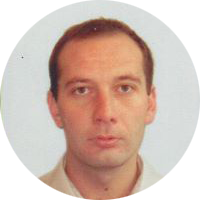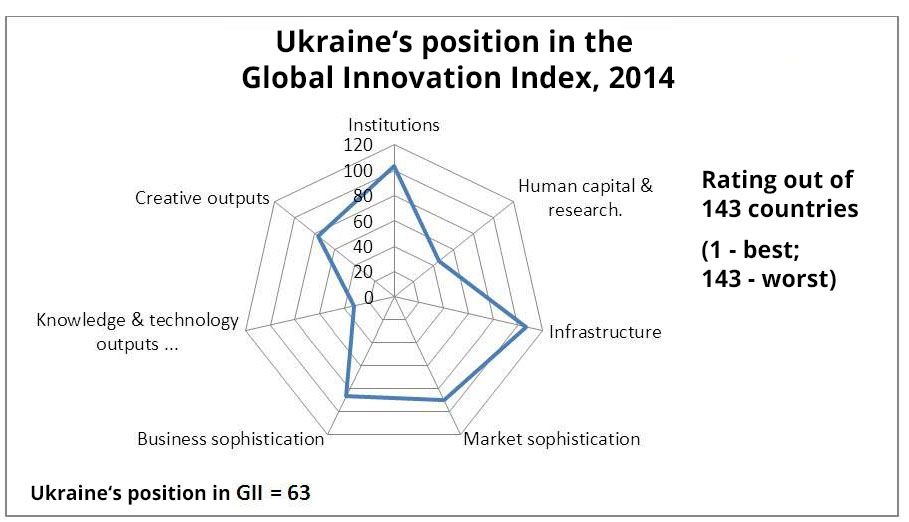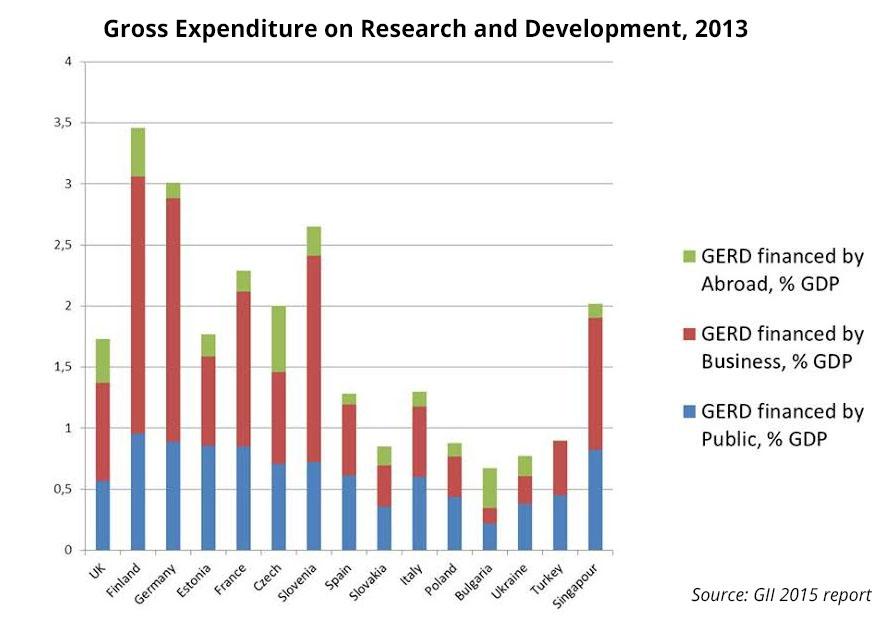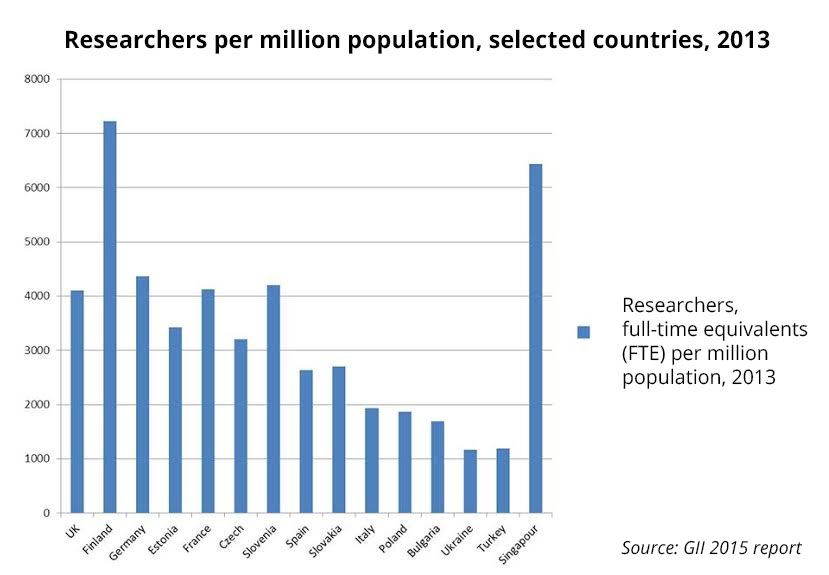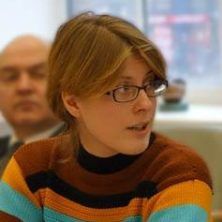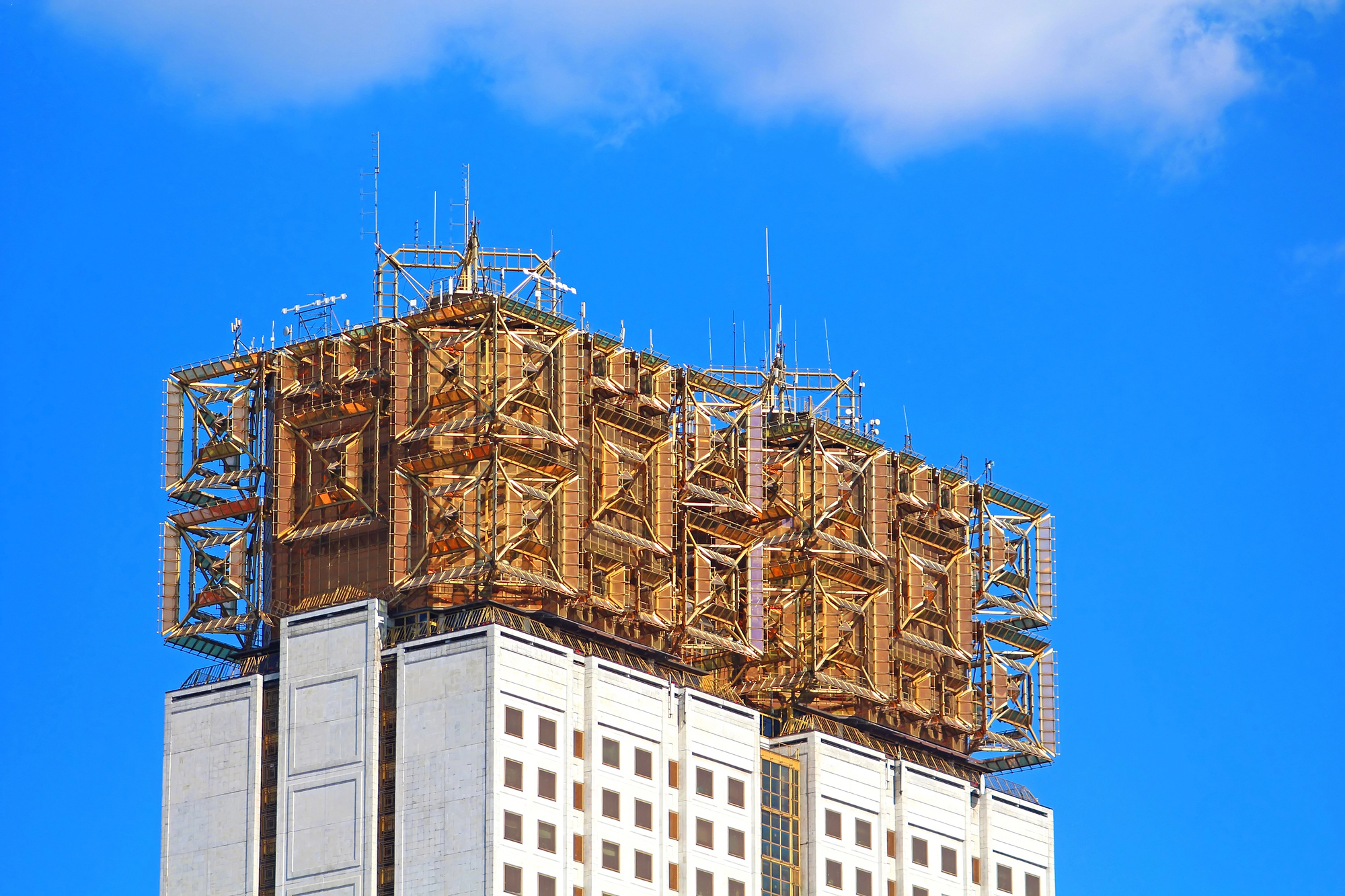A modern country is unthinkable without research and development. However, 25 years of independence have been 25 years of brain drain for Ukrainian science. After Euromaidan, the scientific community was finally able to push through a long-awaited reform that could resuscitate Ukraine’s potential and, possibly, even bring back those that left abroad. If it manages to live through the shockingly severe underfinancing that results from Russia’s covert war in Donbas.
Only underfunded?
When the Soviet Union fell apart in 1991, Ukraine had the second largest scientific potential of the 15 former republics(VoxUkraine: this sentence has been corrected). Soviet science was dominated by ideology and focused on heavy industry and the military, but the 70 years of Soviet rule gave once-agrarian Ukraine a significant scientific potential. However, that potential is imperiled by 25 years of financial crisis and mismanagement in Ukraine’s years of independence, over which Ukrainian science has seen a steady brain drain of researchers seeking better opportunities.
The result is stagnation, well illustrated by the amount of scientific publications in international peer-reviewed journals indexed in the Thomson Reuters WEB of Science (Core Collection) database. In 1992, Ukraine was one of the leaders in its group of countries similar in terms population and economic development (excluding South Korea), lagging just behind Poland. 20 years later, it now lags behind every one of those countries. Russia, with a similar post-Soviet model of science yet a higher starting ground, has also stagnated over the same period (see Figure.1).
Illustration: dt.ua
Those in charge of the National Academy of Science of Ukraine, the country’s leading research institution, have argued that this sad state of Ukrainian science is a result of severe underfunding and that the optimal amount should be 1.7% of the GDP. Partially, they are right. After 1991, a combination of economic crisis and
Partially, they are right. After 1991, a combination of economic crisis and decreasing expenditures to research and development (from 1.19% of GDP in 1997 to 0.75% in 2012; compare to leaders of budget spending on R&D, Israel at 4.25% and South Korea at 4.03%) made Ukrainian science the second least financed ($1,318,000) in the region in terms of absolute values and least financed in terms of amount of GDP spent on R&D per capita ($29 spend on R&D per capita in 2012). Only Romania spends less on R&D in absolute values, but that is balanced by higher expenditures per capita (see Table 1).
Table 1. Research and development expenditure (% of GDP) in 2012, selected countries |
|||||
| % of GDP allocated to R&D (funds: public, private, and abroad) | GDP in 2012, mn $ | GDP per capita in 2012, $ | Amount spent on R&D in 2012. mn $ | Amount spent on R&D per capita in 2012, $ | |
| Turkey | 0.92 | 788863 | 10539 | 7258 | 97 |
| Russia | 1.13 | 2170146 | 15155 | 24523 | 171 |
| Poland | 0.89 | 500228 | 13142 | 4452 | 117 |
| South Africa | 0.73 | 397386 | 7590 | 2901 | 55 |
| Romania | 0.49 | 171665 | 8558 | 841 | 42 |
| Argentina | 0.58 | 604378 | 14357 | 3505 | 83 |
| Ukraine | 0.75 | 175781 | 3855 | 1318 | 29 |
| Israel | 4.25 | 259614 | 32819 | 11034 | 1395 |
| South Korea | 4.03 | 259614 | 24454 | 10462 | 985 |
| World average | 2.17 | 74428357 | 10499 | 1615095 | 228 |
Source: United Nations Educational, Scientific, and Cultural Organization (UNESCO) Institute for Statistics
Russia’s covert war against Ukraine after the Euromaidan revolution has led to a severe economic crisis, leading to a threefold depreciation of the currency and severe austerity measures. Ukrainian researchers were astonished to find out that Ukraine will spend ten times less on R&D in 2016 – a shockingly low $8 per capita. That is not enough to cover even salaries, the average salary being around $200. Institutes have been forced to fire staff and work 3 days a week.
Table 2. Projected research and development expenditure (% of GDP) in 2016 in Ukraine |
||||||
% of GDP allocated to R&D (funds: public) |
% of GDP allocated to R&D (funds: public, private, and abroad) |
Estimated GDP in 2016, mn $ |
Estimated GDP per capita in 2016, $ |
Estimated amount spent on R&D in 2016, mn $ |
Estimated amount spent on R&D per capita in 2016, $ |
|
Ukraine |
0.16 |
0.40 |
81683 |
1907 |
327 |
8 |
Source: index.minfin.com.ua
Estimated GDP for 2016 was calculated based on 2015 values and the Ukrainian National Bank’s prognosis of growth of 1.1% and the 2012 ratio of 0.3% of public funds out of the total 0.75% of GDP allocated to R&D
No, not only underfunded
However, we would be wrong to think that as soon as Ukrainian science starts being well funded all problems will be solved. Despite the falling fraction of GDP spent on R&D, Ukrainian science actually got more investments over 2001-2012, due to overall economic growth. Figure 2 shows that the absolute budgets of Ukraine’s leading scientific institutions grew by approximately 800% (with an inflation rate of 270% over the same period) over 2001-2012; however, this did not result in a rise of productivity of research, as can be seen from Figure 1.
dt.ua, translated by Euromaidan Press
Why has Ukrainian science stagnated after the breakup of the USSR?
Rigid and ineffective management
According to Mykola Iorgov, Head of Laboratory of Theory of Integrable Systems from the Boholyubov Institute for Theoretical Physics, and co-author of Ukraine’s recent science reform legislature, many factors came into play here. The National Academy of Science, the main organization dealing with research in Ukraine, retained its Soviet structure. It has been governed by researchers with the highest academic ranks in Ukraine, “academicians” and “correspondents,” the average age of whom is 80 years, led by 97-year old President Boris Paton. This system worked better in Soviet times when both the GDP and percent of GDP allocated to research was higher, but in times of Ukrainian independence, the Academy has been deemed outdated and resistant to modernization.
As seen by Fig. 3, showing Ukraine’s position in the Global Innovation Index according to different categories, Ukraine has preserved much of its human capital, knowledge and technology from the times of the USSR, while its low rankings on the business, infrastructure, institutions, and market sophistication reflect the absence of developing new market-oriented strategies in the decades after the fall of the USSR.
Figure 3. Ukraine’s position in the Global Innovation Index, 2014.
Source: Report on the Global Innovation Index 2015
Soviet-era orientation no longer relevant
During the Soviet Union, there was a state demand for research and innovation, but a specific one, oriented towards heavy industry and servicing the military sphere, a top-priority field during the Cold War. The technical and fundamental sciences developed quite well, however, the humanities were molded to serve the ideological demands of the communist state. The USSR had rockets, airplanes, and everything that is useful for the military, but didn’t have any good cars, refrigerators, washing machines – the production chain was oriented towards the defense sector. Now it’s gone, and no new chains were built.
The Soviet legacy can be traced in Ukrainian science today – 2/3 of the publications of Ukrainian scientists are in journals dedicated to technical sciences (from Engineering to Chemistry), the remaining 1/3 are split between medical sciences, life sciences, agriculture, and humanities. Compared to the USA, Engineering sciences are overdeveloped in Ukraine, while Medical and Biological sciences are underdeveloped (Figure. 4), reflecting the low value of preserving human life versus the high value of pursuing technological progress under the communist ideology.
Figure 4. A comparison of the sectoral development of science in the USA and Ukraine based on publications in scholarly journals.

Data: nsf.gov (2012), uincit.uran.ua (2015), grouping by author
No business model
The modern Ukrainian government is not interested in developing science and good education, partly because there is no research-oriented production that demands innovative scientific ideas. In Ukraine’s corrupt business environment, enterprises had no need for high-tech manufacturing, as it didn’t provide any competition benefits – providing bribes to the right people was a better factor for business growth. State-level corruption means that those running the country took the simple ways to get rich, avoiding R&D and fostering new ideas.
“If that can be changed, then we will have real competition with the demand of searching for conceptually new ideas, which is impossible without science, and Ukrainian science will develop” considers Mykola Iorgov. According to the expert, Ukrainian science to this day has retained much of its research potential, and it is concentrated mainly in the Academy. It’s difficult to assess how much potential there is specifically, but if it’s liquidated now, it will be much harder to restore it later.
Thus, one of Ukraine’s goals is to reconstruct the chain leading from fundamental research to production.
In this, diversifying the income sources for R&D will be a crucial step – at present, only about 50% of investments for research and development come from non-public funds (see Figure. 5).
Figure 5. Gross expenditures on Research and Development by investment source, 2013.
Source: Global Innovation Index 2015 report
A chance for a change
After the Euromaidan revolution, Ukraine achieved its “historic chance to revitalize science,” according to Nataliya Shulga, Executive Director of the Ukrainian Science Club, an NGO dedicated to boosting Ukrainian science to world level. In 2015, a new law on Research and Science was passed, following many months of work of researchers, institutions, and committees of different profiles. The result is new strategic legislation based on European standards with the potential to speed Ukrainian science out of the post-Soviet past into the XXI century.
The changes this legislation introduces go far beyond science. They suggest solutions to most of Ukraine’s troubles in reform-making:
1. How to ensure that made decisions serve the common good and not for corporate interests?
2. How to ensure that the best people are involved in decision-making?
Involving best minds in decision-making. The law provides allocating up to 50% of votes at the Council of the Academy of Science to delegates from different research institutes, apart from the academicians and correspondents. There are also plans to limit voting rights to only delegates under 80.
Setting new rules for the game. For the first time, the Ukrainian government will receive scientific advisors in a newly created National council for the development of science and technologies, which will include a Scientific Council. It will include 24 best Ukrainian researchers selected by an independent committee, which was in its turn selected by the top-25 Ukrainian researchers with the highest H-index. Out of nine members of the independent committee, six are well-known researchers from outside of Ukraine:
- Carlo W.J. Beenakker, Nominated by the University of Leiden, Netherlands. Professor, Leiden University. Wikipedia.Google Scholar
- George Gamota. University of Michigan (emeritus). Nominated by the Institute of scintillation materials, Ukraine. Biography (narrative – style). CV. Web of Science Core Collection: 19 papers, 95 times cited, h-index =7
- Gusynin V.P. Nominated by the Boholyubov Institute of Theoretical Physics. Web of Science Core Collection: 159 papers, 5982 times cited, h-index =35. Scopus: 135 papers, 5382 times cited, h-index=34. Google Scholar: 8601 citations, h-index=44
- Oleg Lavrentovich, Nominated by Kent State University, USA. Trustees Research Professor, Liquid Crystal Institute, Kent State University. Lavrentovich Group web site. Google Scholar
- Mats L. Larsson. Nominated by the Institute of Condensed Matter Physics (Lviv, Ukraine), Professor at Stockholm University, Member of the Royal Swedish Academy, Sweden’s CERN representative (1999-2004), Head of the Sweden Research Council on Natural Sciences, Member of the Nobel Committe on Physics 2016-2018
- Riabchenko S.M. Nominated by the Ukrainian Physical Society.Wikipedia. Web of Science Core Collection: 161 papers, 1008 times cited, h-index =16. Scopus: 108 papers, 628 times cited, h-index=13
- Bertrand Halperin. Nominated by Harvard University, USA. Professor at Harvard University, USA (CV, Papers). Member: National Academy of Sciences (USA); American Philosophical Society. Fellow: American Physical Society; American Academy of Arts and Sciences. Awards: Lars Onsager Medal and Lecture, Norwegian University of Science and Technology (2009); Dannie Heineman Prize of the Göttingen Akademie der Wissenschaften (2007); Wolf Prize in Physics (2003); Lars Onsager Prize, American Physical Society (2001); Oliver E. Buckley Condensed Matter Physics Prize, American Physical Society (1982). Wikipedia. Google Scholar
- Shkuratov Yu.H. Nominated by the Karazin National University of Kharkiv. Biography. Web of Science Core Collection: 178 papers, 2890 times cited, h-index =30. Scopus: 188 papers, 3077 times cited, h-index=31. Google Scholar: 1254 citations, h-index=22
- Günter Stock. Nominated by Berlin-Brandenburg Academy of Sciences and Humanities, Germany. Wikipedia. President of the European Federation of Academies of Sciences and Humanities (ALLEA)
Limiting tenure of directors. Now, the tenure of a director of a research institution is limited to up to two terms of five years.
Objectively evaluating available resources. A commission has been created as part of the EU’s framework for Research and Innovation, HORIZON 2020, which is set to assess Ukraine’s scientific sphere until 1 September 2016 and make recommendations for improvement.
Transparent and competitive distribution of financing. As Ukraine’s GDP rises and more funds are allocated to science, it will be necessary to ensure they are used effectively. For this reason, a National Scientific Fund will be created and a Council that will oversee the distribution of funds based on an open competition. To ensure maximum transparency and merit, members of this Council will be selected by the Scientific Council.
Limiting lobbying of corporate interests in scientific decision-making. As opposed to the “quota principle” when each institution sends a determined number of delegates to vote for choices, the Identifying Committee for the Scientific Council was selected based on the academic merit of participants. The “quota principle” had proven itself to be unproductive in other situations, when directors appointed the “right” delegates that would lobby for their institution’s corporate interests, but not make decisions that would be good for the field in the long run.
The situation in the Scientific Council now gives a chance for building a system that would foster academic excellence instead of corporate lobbying.
Possibly, this is a strategy that prevents rational decision-making in Ukraine overall – under conditions of limited resources and opaque ways of distributing them, the livelihood of institutions depended on their abilities to procure the largest share from the pot, at the expense of strategic planning.
Meanwhile, the brain drain continues
According to Nataliya Shulga, the situation with science in Ukraine is critical: “We have a critical situation with science in Ukraine. People don’t understand that science is the basis of all the economies of successful countries. If you don’t create working conditions for researchers, an atmosphere that produces new knowledge, you make your own economy powerless, you can’t offer anything to the world, can’t sell anything. Over the last years, we lost over 20,000 young, motivated researchers, which left the country. This is a loss that is equal to the amount of researchers who are still left in the Academy of Science,” she told in an interview to Hromadske Radio. Over 2014-2015, the number of researchers working in the Academy of Science decreased by 13% – 5619 people in absolute numbers, and they are seldom young – only 20% of researchers in the Academy with a PhD are under 35.
Director of Ukraine’s National Fund for Fundamental Research Borys Hryniov shares Ms.Shulga’s concern, asserting that a colossal brain drain is taking place, and the ‘draining’ starts already from the school bench. “What is most impressive, nobody at the top is attempting to tackle the problem,” he said in an interview to dt.ua. Raising the net amount of researchers is thus one of Ukraine’s foremost goals in its R&D strategy, with the current numbers being considerably below those of other European countries (Figure. 6).
Figure 6. Researchers per million population, 2013.
Source: Global Innovation Index 2015 report
The new legislature gives Ukraine a chance to finally reverse this flow and start producing scientific products at home. However, as with every other field of reform in Ukraine, the prospects of a flourishing R&D field will depend on how many researchers resist the urge to emigrate and stay and work to develop their own country, sometimes, against odds.
Partner’s article. The article initially was published at euromaidanpress.
The author is sincerely grateful to Mykola Iorgov for his help, comments, and proof-checking of this article, and Andriy Shevchenko for Fig.3, 5, 6. More information on science reform in Ukraine can be found on its official information portal.
Attention
The author doesn`t work for, consult to, own shares in or receive funding from any company or organization that would benefit from this article, and have no relevant affiliations


